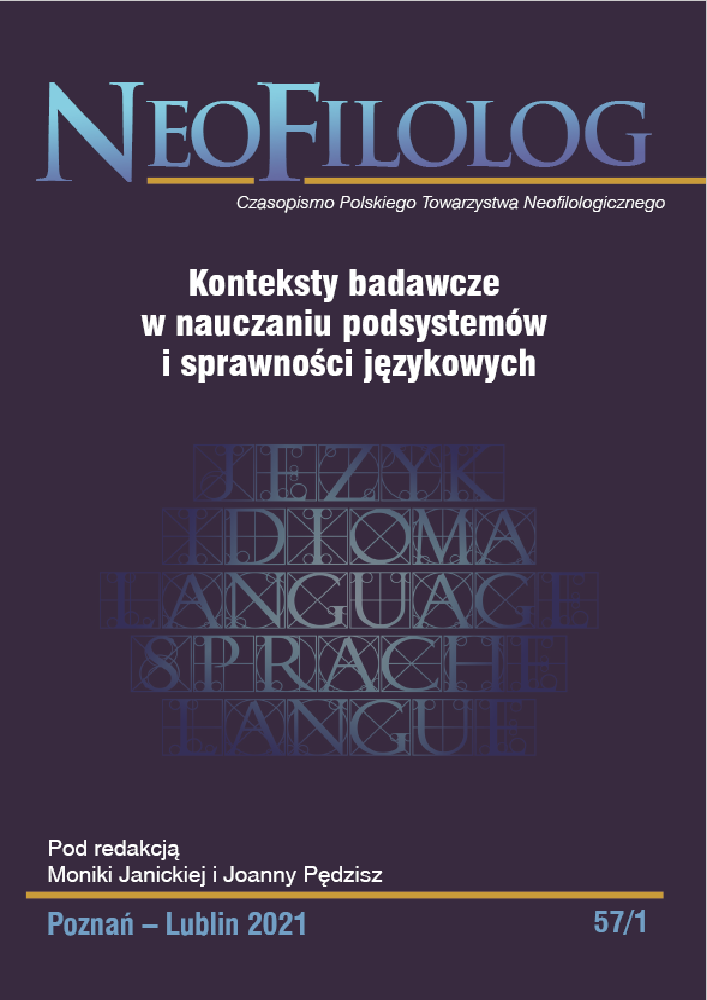Abstract
Not only special educational needs, but also developmental traits strongly determine the specificity of lexical repertoire teaching process of foreign language in preschool education. The aim of this paper is to present the results of a study carried out among a group of 5-year-old autistic and Asperger children. The purpose of this particular pedagogical context of preschool education is to discuss some difficulties and their feasible modifications into methodical possibilities. First of all, with the aid of neurobiological perspective the specificity of lexical repertoire teaching among children will be presented. Furthermore, particular needs and abilities of the children with autism spectrum disorder and Asperger syndrome will be discussed. The practical part of this paper was based on a research conducted in 2018/2019 in Warsaw. The study enabled us to diagnose whether the application of the multiple intelligences’ theory, the multisensorial tasks and the didactic game in the context of preschool special education affects the learning – teaching process of the foreign language.
Literaturhinweise
Alexiou T., Milton J., Roghani S. (2019), Assessing the Vocabulary Knowledge of Preschool Language Learners. Integrating Assessment into Early Language Learning and Teaching, United Kingdom: Multilingual Matters, s. 154-164.
Cichmińska M. (2015), Bawię się więc jestem. „Języki Obce w Szkole”, nr 1, s. 13-17.
Dufrêne G., Chambres E., Chambres P. (2009), Le syndrome d’Asperger: atouts et particularités. „Bulletin scientifique de l’arapi”, nr 23, s. 59-65.
Gardner H. (1983), Frames of Mind: The Theory of Multiple Intelligences. New York City: Basic Books.
Hüther G., Hauser U. (2014), Wszystkie dzieci są zdolne. Jak marnujemy wrodzone talenty. Słupsk: Wydawnictwo Dobra Literatura.
Kic-Drgas J. (2015), Czym skorupka za młodu nasiąknie…, czyli kilka uwag o kształceniu interkulturowym najmłodszych. „Języki Obce w Szkole”, nr 1, s. 36-42.
Komorowska H. (2005), Metodyka nauczania języków obcych. Warszawa: Fraszka Edukacyjna.
Konderak T. (2017), Podejście wielozmysłowe w nauczaniu języków obcych dzieci. „Edukacja elementarna w teorii i praktyce”, nr 4(46), s. 97-99.
Kondrat D. (2011), Wykorzystanie inteligencji wielorakich w nauczaniu języka angielskiego. „Języki Obce w Szkole”, nr 4, s. 2-10.
Kotarba-Kańczugowska M. (2015), Przedszkolak uczy się języka obcego. Kręta droga, wielka frajda. „Języki Obce w Szkole”, nr 1, s. 43-49.
Medina J. (2012), Jak wychować szczęśliwe dziecko. Kraków: Wydawnictwo Literackie.
Milton J., Alexiou T. (2009), Vocabulary size and the Common European Framework of Reference for Languages, (w:) Richards B., Daller H. M., Malvern D.D., Meara P., Milton J., Treffers-Daller J. (red.), Vocabulary Studies in First and Second Language Acquisition. Basingstoke: Palgrave Macmillan, s. 194-211.
Ministère de l’éducation nationale (2009), Scolariser les élèves autistes ou présentant des troubles envahissants du développement. Paris : CNDP.
Mottron L. (2004), L’autisme: une autre intelligence. Sprimont: Mardaga.
Mottron L. (2010), Que fait-on de l’intelligence autiste? „Enfance”, nr 1, s. 45-57.
Piotrkowska-Skrzypek M. (2015), Kompetencje nauczyciela języka obcego w przedszkolu. „Języki Obce w Szkole”, nr 1, s. 23-31.
Pisula E. (2010), Autyzm. Przyczyny, symptomy, terapia. Gdańsk: Wydawnictwo „Harmonia”.
Sowa-Bacia K. (2019), Kryteria wyboru materiałów dydaktycznych w nauczaniu języka obcego na etapie przedszkolnym. „Języki Obce w Szkole”, nr 5, s. 75-79.
Tiefenthal C. (2008), Fast mapping im natürlichen L2-Erwerb. Trier: WVT.
Vanthier H. (2009), L’enseignement aux enfants en classe de langue. Paris : CLE International.
Wierzchosławska A. (2018), Nauczanie multisensoryczne w przedszkolu wraz z przykładami ćwiczeń. „Języki Obce w Szkole”, nr 1, s. 48-50.
Wolski A. (2013), Ograniczone, powtarzające się̨ i stereotypowe wzorce zachowań, zainteresowań i aktywności u małych dzieci ze spektrum autyzmu. „Konteksty pedagogiczne”, nr 1, s. 45-63.
Wójcik-Gugulska M. (2017), Zajęcia z dużą grupą przedszkolaków mogą być świetną zabawą! „Języki Obce w Szkole”, nr 2, s. 104-107.
Lizenz
Copyright (c) 2021 Monika Szymańska

Dieses Werk steht unter der Lizenz Creative Commons Namensnennung - Keine Bearbeitungen 4.0 International.
Autoren:
Die Autoren der zur Veröffentlichung in der Zeitschrift Neofilolog angenommenen Texte sind verpflichtet, den Vertrag über die Erteilung einer kostenlosen Lizenz für die Werke mit der Verpflichtung zur Erteilung einer Sublizenz CC auszufüllen, zu unterzeichnen und an die Adresse der Redaktion zurückzusenden.
Gemäß Vertrag erteilen die Autoren auf die in der Zeitschrift Neofilolog veröffentlichten Texte der Adam-Mickiewicz-Universität in Poznań eine nicht exklusive und kostenlose Lizenz und erlauben die Verwendung der Sublizenz Creative Commons Attribution-NoDerivatives 4.0 International (CC BY-ND 4.0).
Die Autoren behalten das Recht zur weiteren freien Verfügung über das Werk.
Benutzer:
Interessierte Onlinebenutzer dürfen die seit 2017 veröffentlichten Werke unter folgenden Bedingungen nutzen:
- Anerkennung der Urheberschaft - die Verpflichtung, zusammen mit dem verbreiteten Werk Informationen über die Urheberschaft, den Titel, die Quelle (Links zum Originalwerk, DOI) und die Lizenz selbst bereitzustellen;
- ohne Schaffung abgeleiteter Werke - das Werk muss in seiner ursprünglichen Form erhalten bleiben, ohne Zustimmung des Autors dürfen keine Studien, beispielsweise Übersetzungen, verbreitet werden.
Die Urheberrechte aller veröffentlichen Texte sind vorbehalten.
Sonstige:
Die Adam-Mickiewicz-Universität in Poznań behält das Recht auf die Zeitschrift als Gesamtheit (Layout, Grafik, Titel, Umschlagsprojekt, Logo usw.).

